Brown toilet water looks horrible, and it can be a frustrating issue to deal with if you don’t know the cause.
Whether you’re concerned about what guests might think or you’re worried that your brown toilet water might be leaving permanent stains, you probably want to find a solution to the problem as soon as possible.
Here, you’ll find the 8 most likely causes of brown toilet water, and how to fix them.
📌 Key Takeaways:
- Brown water in a toilet is likely caused by rusted or corroded pipes, sediment, a blockage in your plumbing line, rusted toilet components, or iron bacteria.
- You can remedy brown toilet water by flushing the toilet a few times, unclogging blocked pipes, increasing your toilet’s flush power, or installing a water treatment system to remove contaminants causing brown discoloration.
- If you can’t solve the problem or you’re uncertain about the cause, you might want to hire a professional plumber to take a look.
Table of Contents
🤔 Why Is My Toilet Water Brown? 8 Causes
Wondering, “Why is my toilet water brown?” We’ve shared the most common causes of brown water in toilet below.
Standing Water & General Use
Toilets are dirty environments, so it’s unsurprising that over time, your toilet water will take on a brown color if you don’t bring out the cleaning supplies as often as you should.
It’s normal for water in your toilet to take on a gray-brown color or dirty tinge after a few weeks of no cleaning.
Allowing water to stand too long in your toilet will also cause it to appear dirty. If you return from a vacation and your toilet has been unused for a few weeks, you might discover that the water has a brownish hue.
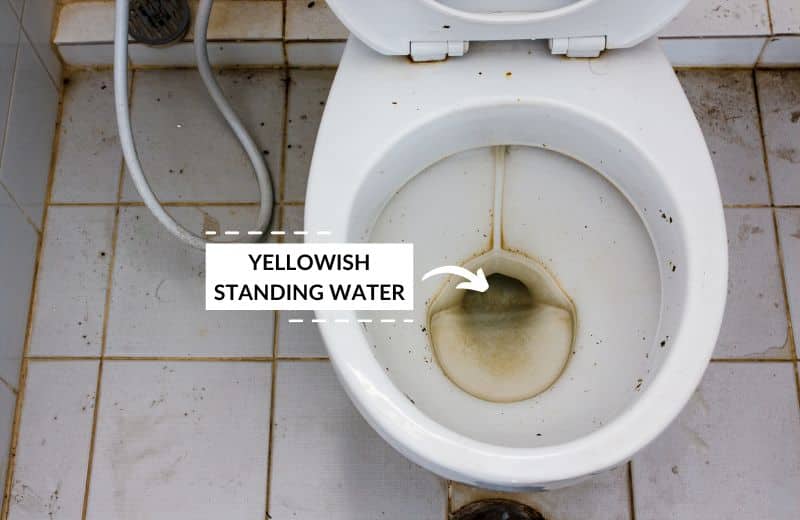
Rusty Pipes
Does your toilet water have bits of browny-orange particles floating in it? Or have you noticed orange-brown stains in your toilet tank or bowl? If so, you probably have rusty pipes in your home.
Old metal pipes, such as iron or galvanized steel pipes, produce rusty residue when they corrode. Over time, rusted pipes will release small amounts of rust into your water, which end up contaminating your toilet.
You might have rusty or corroded toilet pipes, or rusted pipes further upstream in your water supply.
Rusted Toilet Components
The components in your toilet could also have rusted, leading to brown-looking water in the toilet tank or bowl.
Old toilets are especially prone to rust since they often contain untreated metal components. It can be difficult to determine the exact cause of the rust since the particles in your water will eventually cause the entire toilet tank and bowl to rust.
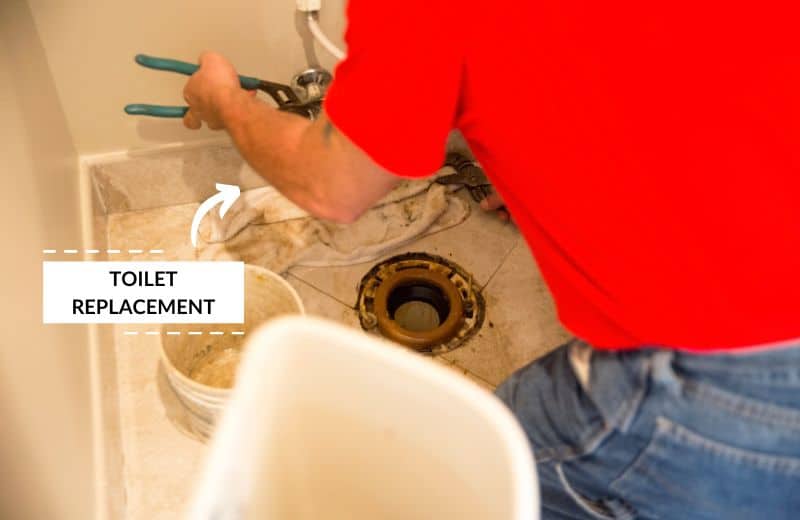
Iron
Iron is a common well water contaminant that gives water an orangey-brown appearance.
Iron isn’t dangerous, but too much iron in your water supply can leave unsightly, difficult-to-remove stains on your water pipes, fixtures, and water-using appliances.
If your drinking water also tastes metallic, it’s likely that iron is the cause of your brown toilet water problem.
Iron Bacteria
In some cases, iron and manganese in your water might combine with natural bacteria in soils and surface water, forming iron or manganese bacteria.
Iron or manganese bacteria form sludge-like deposits that are orange or dark brown in water. Your water might also smell unpleasant and have floating particles of orange or brown.
If allowed to accumulate, iron and manganese bacteria may lead to a clogged toilet.
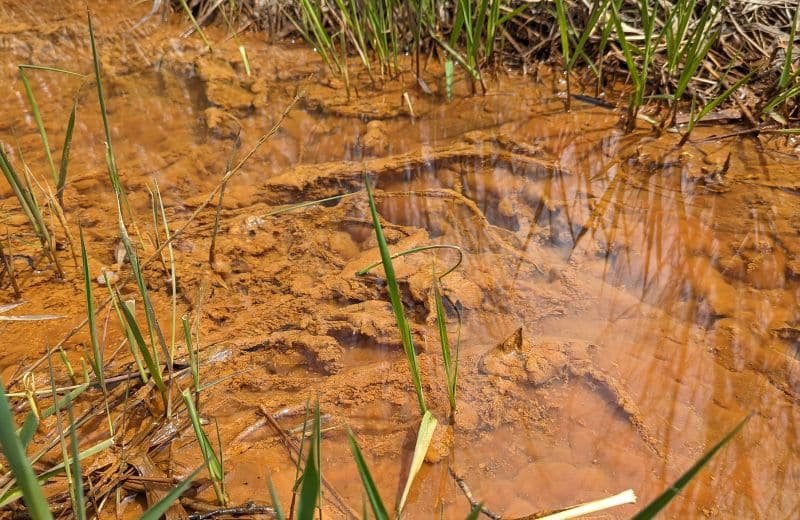
Sediment & Dirt
If you have a private well water supply, brown water in your toilet might be caused by too much sediment and dirt in your water.
Well water is naturally higher in sediment than city water because a well aquifer contains sand, silt, dirt, and other debris. Some of this gets drawn into the well through the pump.

However, if your water sediment levels are high enough to discolor your toilet water, you might have an issue that needs resolving.
Mineral Deposit Buildup
Hard water is an incredibly common problem in the US. While hard minerals aren’t dangerous to human health, hard water mineral buildup looks unsightly and may be the cause of your discolored toilet water.
Usually, limescale deposits are chalky white or yellow in color, but if other nasties and dissolved organic matter in your toilet water stick to these stains, you could end up with brown water.
Plumbing Line Blockage
Do you notice brown water in your toilet when you flush it? A blockage in your plumbing might be turning your toilet water brown.
A properly functioning plumbing system sends water evenly and smoothly down the drain when a toilet is flushed. But if you have clogged pipes leading from the toilet, the water flow may reduce, causing a backup of dirty water in the toilet.
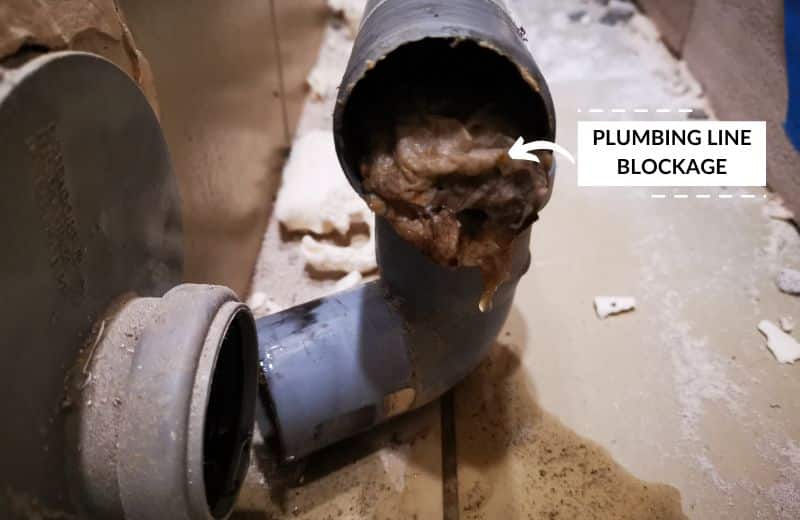
🪛 How To Fix Brown Toilet Water
Follow these steps to fix brown water in your toilet.
Flush The Toilet A Few Times
First, try flushing the toilet a few times.
A fresh batch of water in your toilet might look clean and clear. Plus, as water flows through the toilet, it may dislodge any contaminants causing brown staining inside the toilet bowl.
For added effect, place a toilet cleaning block beneath the seat rim, which will send cleaning chemicals into your water every time you flush, keeping the standing water clean and fresh.
Increase Your Toilet Flush Power
If your dirty toilet water is caused by your toilet’s inability to completely flush everything away, you can fix the issue by increasing your toilet’s flush power.
Simply by repositioning the cylinder float or lifting the float in the toilet tank, you should increase the flow of water from your toilet when you flush. Now, the toilet should be powerful enough to remove everything with just one flush.
Note: make sure that your toilet’s flush power is to blame, and NOT a blockage in the toilet pipes, or you might end up flooding your toilet by increasing the flush power.
Fix Your Well
If you have a private well and you’re concerned that sediment in your toilet water has turned it brown, you might have an issue with your well that needs fixing.
For instance, a well pump that’s too low in the aquifer may be drawing in too much sediment, and you might need to hire a well contractor to raise the pump by several inches.

Or, the well screen could be damaged or degraded, allowing large quantities of sediment into your water supply. You’ll need to replace or repair the screen as advised by a professional.
Rusting well components could also cause iron flakes to get into your water, and you may need to replace these components to prevent further damage.
Consult a Plumber
If you suspect clogged pipes are the cause of your brown toilet water, and you can’t resolve the issue yourself, call your local plumber.
A plumber can fix dirty toilet water by flushing or replacing blocked pipes, depending on the extent of the blockage.

You might also need to hire a plumber if you think that you have a major corroding or rusting issue in your pipes that’s causing your toilet water to take on a brown tinge. A plumber can inspect your pipes and advise you on whether or not you need to replace some or all the pipes in your home due to corrosion.
🚫 How To Prevent Future Brown Toilet Water
You might have temporarily fixed the brown water in your toilet by flushing or cleaning – but how can you prevent the brown stains from coming back?
Follow our advice below.
Install A Water Treatment System
The best way to prevent brown water in your toilet is to install a suitable water treatment system to tackle the brown-causing contaminant. We’ve shared a few possible systems to choose from below.
Iron: Air Injection System
If your toilet water is brown due to iron in your water supply, install an air injection/oxidation system. AIO systems send water through an air bubble, which oxidizes contaminants like iron. These impurities are then filtered out of the water by a bed of birm or manganese greensand. AIO filters can usually remove around 10-15 PPM of iron.
Mineral Deposits: Water Softener
If hard mineral deposits are to blame, install a water softener system. Water softeners exchange calcium and magnesium hardness minerals with harmless ions that are unable to form mineral deposits (usually sodium). Water softeners should be installed upstream of your hot water heater to protect your entire home’s water supply from scale buildup.
Sediment: Sediment Water Filter
If your toilet water is brown due to sediment in your water supply, install a sediment filter in your plumbing system. Sediment water filtration systems remove sediment particles of a variety of sizes, depending on the filter type and pore size. Some people install multiple sediment filters to filter out sediment in different size ranges.

Regularly Clean & Maintain The Toilet
Your toilet won’t have a chance to accumulate dirt and other nasties if you keep it clean and well-maintained.
Clean your toilet with bleach or a powerful, non-toxic alternative at least once a week to prevent staining in the toilet bowl. This will also reduce the likelihood of clogging in the water pipe connecting the toilet to your drain.
You should also maintain the toilet as necessary. Check for leaks, replace worn parts when needed, and don’t flush anything other than toilet paper.
🧽 How To Brown Yellow Water Stains From Toilet
So, you’ve established a permanent anti-brown water solution for your toilet. You should never get brown water again – but what can you do with existing staining?
Before you buy an entirely new toilet, try cleaning the stains with a powerful, natural solution: white vinegar.
Here’s how to use vinegar to clean brown water deposits out of your toilet:
- Gather your supplies. You’ll need a few basic essentials: a toilet brush, distilled white vinegar, and (optional) baking soda.
- Pour vinegar into the toilet bowl. Fill a cup with white vinegar and pour it into the toilet. Let the vinegar sit in the toilet bowl overnight.
- Clean the toilet. The following day, gently scrub the toilet bowl with a toilet cleaning brush. This should lift the stains that haven’t already been dislodged by the vinegar.
- (Optional) add baking soda. Vinegar is even more effective when combined with baking soda. If you’re dealing with heavy staining, sprinkle a small fistful of baking soda into the water. You’ll notice the water fizzing as the vinegar and baking soda react.
- Flush the toilet. Leave the solution for another 10-15 minutes, then flush the toilet. Use the toilet brush to scrub away any lingering stains if they remain after the toilet water settles.
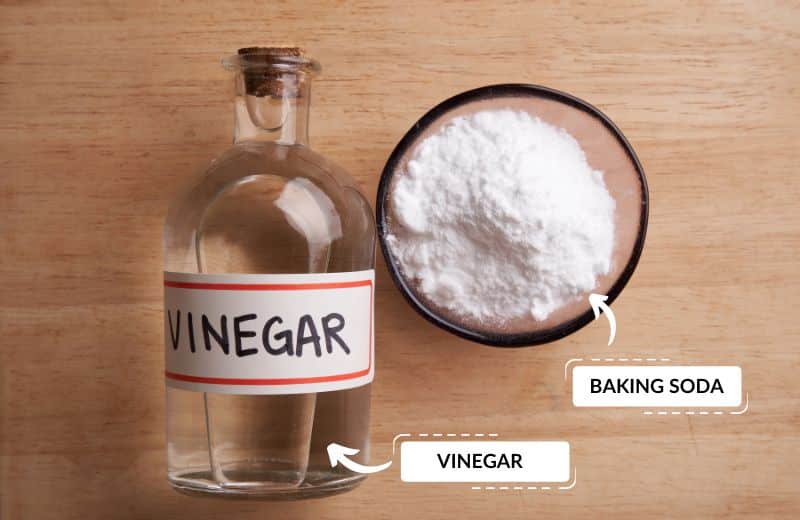
❔ Why Is My Toilet Water Brown? FAQ
Why does my toilet water look dirty?
Your toilet water might look dirty if you haven’t cleaned the toilet for a while, you haven’t used a powerful enough cleaner, you’ve recently been on vacation and left standing water in the toilet, or your toilet water contains contaminants that have caused it to turn brown.
How do you fix brown toilet water?
You can fix brown water in your toilet by installing a water treatment system to remove brown-causing contaminants, cleaning the toilet, and addressing any other issues that might be to blame (such as corroded pipes or a problem with your well).
Why is my water brown in only one bathroom?
Your water might be brown in only one bathroom if there’s an issue in the water pipes leading to this one bathroom. For instance, if the pipes leading to one bathroom are corroding, it could cause rust and metals to get into your bathroom water, giving it a brown tinge.
Why is my toilet flushing dirty water?
Your toilet might be flushing dirty water if there’s something blocking your plumbing lines that’s preventing the proper flow of water out of the toilet, causing a backup of dirty water. You can usually resolve this issue by unclogging or replacing the blocked pipe.
